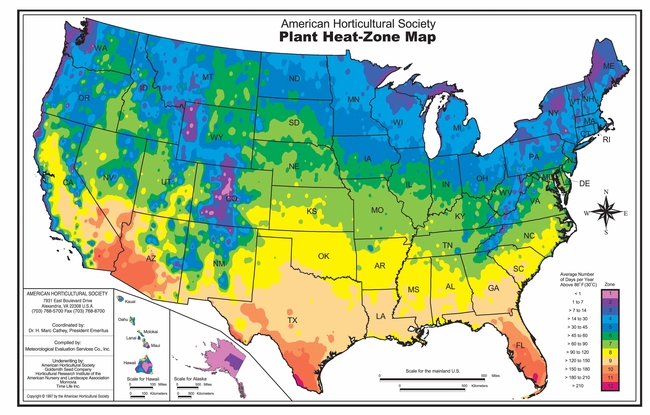By Barbara Ott, Butte County Master Gardener, July 15, 2016.
Most gardeners are aware of the national USDA Hardiness Zones and the Sunset Climate Zones. The USDA zone map is primarily used to assess if a plant has the ability to survive freezes, while the Sunset zones take into consideration a number of other factors as well, includinglength of growing season, timing and amount of rainfall, humidity, wind, and summer high temperatures, as well as winter low temps. Especially because our local Mediterranean climate experiences a great number of very hot days each year, Butte County gardeners must also pay attention to whether a plant can survive full summer sun plus excessive heat.
Most plant labels will state the lowest USDA zone in which the plant will survive in the winter. And a label might indicate that the plant can tolerate (or even require) “full sun.” But how many plants have been purchased because they fall within the appropriate USDA zone and seem to thrive in full sun until that “full sun” climate includes a run of days when temperatures exceed 100 degrees? A conscientious gardener works hard at placing plants in ways that insure strong growth and survival over time. And yet many gardeners who have turned to Mediterranean or native plants because of our prolonged drought may find that even some of these plants cannot survive full sun plus full summer heat in the Sacramento Valley. It can be frustrating to do everything in one's power to help plants survive, only to find that those carefully-chosen and maintained plants cannot handle full sun plus extremely high heat.
Heat damage is subtle. Plants die quickly when they freeze, but when they experience too much heat they can hang on in a sickly manner as flower buds dry up and fall off; leaves droop and are munched by insects; leaves lose their green coloring; and roots stop growing. Plants dying from heat can linger on for years, becoming increasingly stunted and chlorotic, until finally enzymes fail and the plant dies.

How can you find out how much heat a plant can take when placed in full sun or partial sun? The American Horticultural Society (AHS) has developed a tool that can help us choose appropriate plants for our climate and guide us in placing those plants in optimum locations. This is the AHS Plant Heat-Zone Map.
The AHS Plant Heat Zone Map is based on twenty years of daily high temperatures gathered from nearly 5,000 weather stations across the country by the National Climatic Data Center. The color-coded map indicates 12 nationwide zones based on the average number of days annually that an area experiences heat days in which temperatures exceed 86 degrees Fahrenheit. When temperatures top 86 degrees, plants begin showing signs of physiological damage caused by heat. The AHS Heat Zones range from Zone 1 (less than one heat day) to Zone 12 (more than 210 heat days). Chico and Oroville are in AHS Heat Zone 8 (91 to 120 days over 86 degrees); Paradise and Magalia are in AHS Heat Zone 7 (61 to 90 heat days). The AHS Plant Heat-Zone ratings are based on the assumption that a plant is being adequately watered at all times, because heat damage is linked to an insufficient amount of available water. The ability of a plant to survive in a Heat Zone (or even outside of its designated Heat Zone) can be affected not only by water use, but also by light exposure, day length, air circulation, and proximity to nearby structures, among other factors.
For example, placing a “full-sun” plant in a morning-sun only location might be appropriate if you are in the plant's hottest recommended heat zone. And, because on a hot day fast-moving air can quickly dehydrate a plant, taking fences or other structures into consideration when locating a plant, or even planting hedges to cut down on rapid air flow, can be helpful strategies in our somewhat challenging climate.
Alas, at this date most nursery plant labels do not indicate their AHS Heat Zones, but that is changing. Thousands of garden plants have been coded for heat tolerance, and more are presently being coded. Here are some examples:
Gardenia jasminoides “Veitchii.” This plant is listed as USDA Hardiness Zones 8 – 11, AHS Heat Zones 12 – 8, and Sunset zones H1, H2, 7-9, 12-16, and 18-24. That Heat Zone number indicates that it may do better in the warmer valley areas of Chico and Oroville than in the higher (cooler) ranges of Paradise and Magalia.
Kerria japonica is listed as appropriate for USDA zones 5-9, AHS Heat Zones 9-1, and Sunset zones 2-23; while it falls into our local climate zones on each of these zone maps, in Chico and Oroville our AHS zone of 8 means that placing Kerria where it will get some relief from hot afternoon sun (even though it is a “full sun” plant) may be well advised.
One useful site that lists AHS Heat Zones for plants is http://www.learn2grow.com/plants.
For more information on the American Horticultural Society and its Plant Heat-Zone Map, see AHS Plant Heat Zone Map.